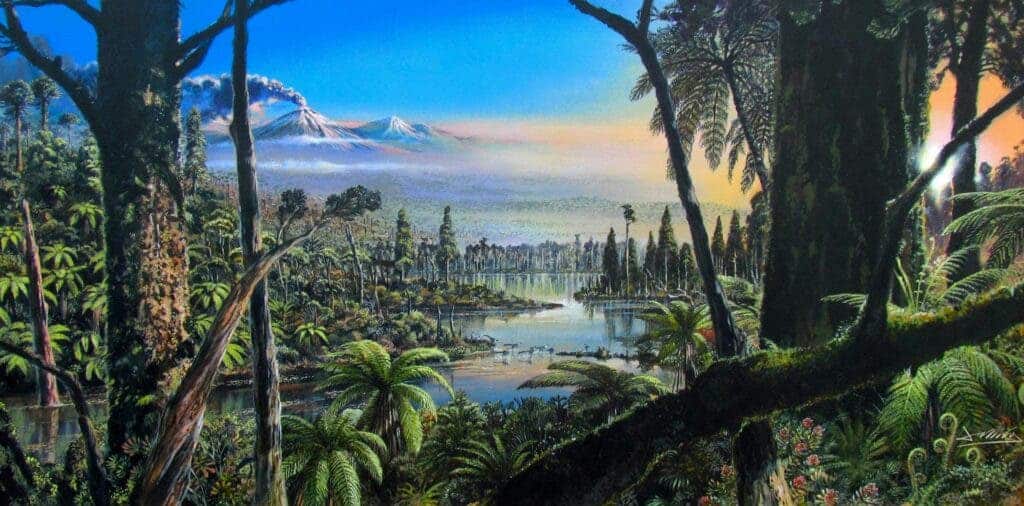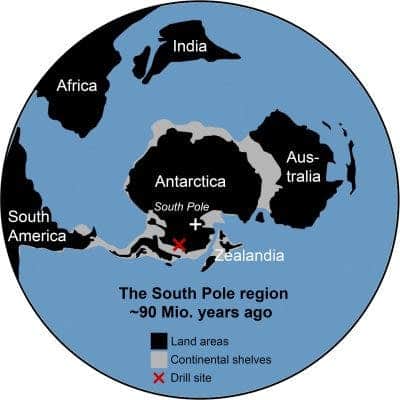
The icy continent of Antarctica wasn’t always the barren landscape that we all know today. As early as 90 million years ago, the continent may have been covered in a temperate rainforest, similar to what you’d find in today’s New Zealand, instead of an ice cap.
The study was carried out by an international team of experts who analyzed preserved roots, pollen, and spores found in cores of sediment drilled within 900 kilometers of the South Pole.

The fossilized soil is estimated to be 90 million years old, placing it in the mid-Cretaceous, a geological period during which the dinosaurs were at their heyday.
This was also the warmest period in the past 140 million years, with temperatures easily reaching 35 degrees Celsius in the tropics. Sea levels were also a staggering 170 meters (560 feet) higher than today.
However, not much is known about what the environment looked like in the South Pole during that period.
Researchers knew they were on to something when they noticed a strange color in a section of a sediment core drilled into the seabed near the Pine Island and Thwaites glaciers in West Antarctica.
“During the initial shipboard assessments, the unusual colouration of the sediment layer quickly caught our attention; it clearly differed from the layers above it,” said first author Dr Johann Klages, a geologist at the Alfred Wegener Institute Helmholtz Centre for Polar and Marine Research in Germany.

Upon analyzing this section with computer tomography techniques, the scientists came across a dense network of fossil roots. The samples were pristinely preserved, allowing the researchers to make out individual cell structures. There were even remnants of flowering plants — the earliest ever found at such high Antarctic latitudes.
In order to establish the climatic conditions of the time, the team compared the environments in which the fossilized plants’ modern descendants live. They also took into account temperature and precipitation indicators within the sample.
“It was particular fascinating to see the well-preserved diverse fossil pollen and other plant remains in a sediment deposited some 90 million years ago, near the South Pole,” said Professor Ulrich Salzmann, a palaeoecologist at Northumbria University and co-author of the new study.
“The numerous plant remains indicate that the coast of West Antarctica was, back then, a dense temperate, swampy forest, similar to the forests found in New Zealand today,” he added.
The analysis suggests that the annual mean air temperature in the South Pole at the time was around 12 degrees Celsius. For comparison, that’s two degrees warmer than the mean temperature in Germany today.
Summer was much warmer, with temperatures hovering at around 19 degrees Celsius, while rivers and swamps were likely around 20 degrees in temperature. Regarding precipitation, Antarctica was probably as rainy as today’s Wales.
Considering these climatic conditions, Antarctica was completely ice-free. This was despite a four-month polar night, meaning for a third of every year there was no life-giving sunlight at all.
“The preservation of this 90-million-year-old forest is exceptional, but even more surprising is the world it reveals. Even during months of darkness, swampy temperate rainforests were able to grow close to the South Pole, revealing an even warmer climate than we expected,” said Professor Tina van de Flierdt, from the Department of Earth Science & Engineering at Imperial College London.
Antarctica’s surprisingly warm and tropical past suggests that carbon dioxide levels in the atmosphere were much higher than expected during the mid-Cretaceous period, which lasted from 115 to 80 million years ago. According to the researchers, CO2 levels may have been as high as 1680 parts per million (ppm), roughly four times higher than they are today.
“Before our study, the general assumption was that the global carbon dioxide concentration in the Cretaceous was roughly 1000 ppm. But in our model-based experiments, it took concentration levels of 1120 to 1680 ppm to reach the average temperatures back then in the Antarctic.”
The findings were published in the journal Nature.









